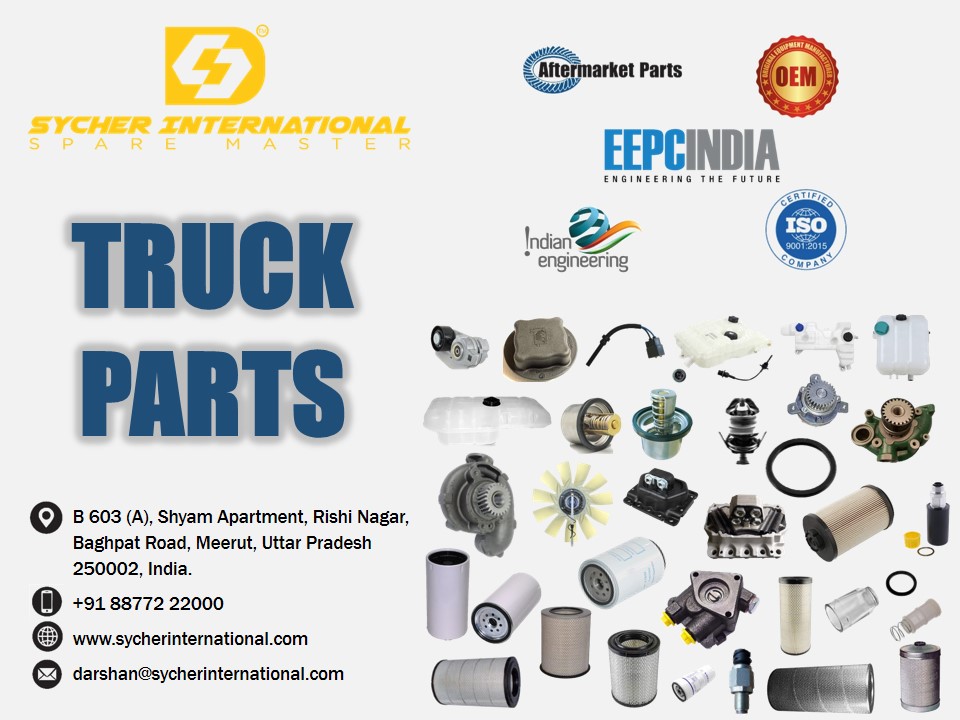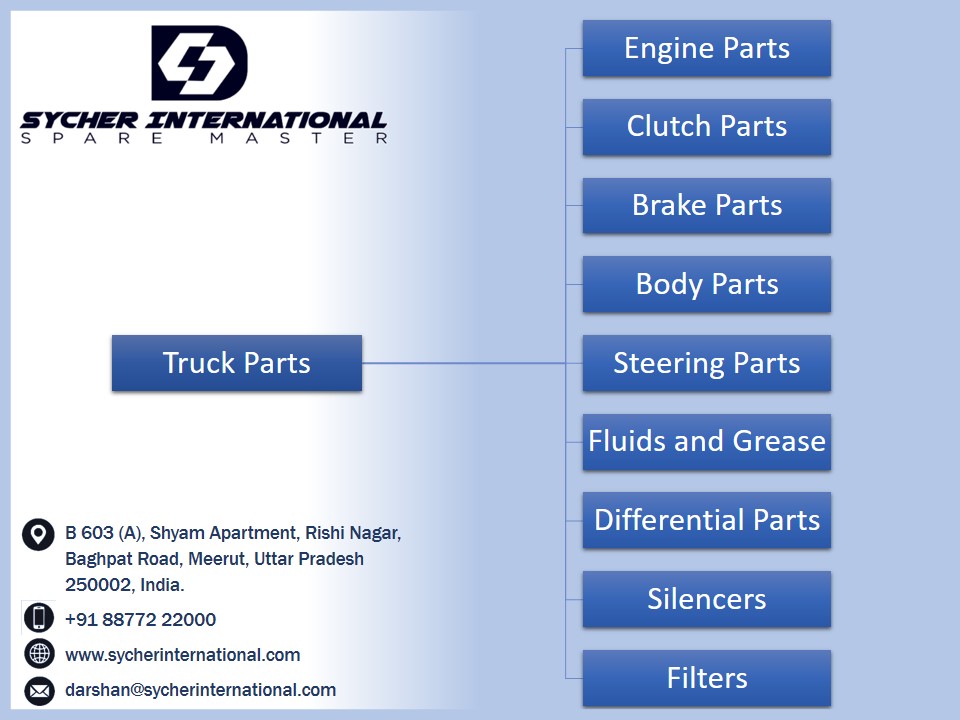What are the common parts of a truck?
Some typical truck components include the fuel tank, storage space, wheels, engine, radiator, horn, cab, and fifth wheel. Let's talk about some essential truck components. The driver can attach a cargo attachment to the back of a big vehicle, like a tractor or truck, using a fifth-wheel hitch.

Fuel Tank: The fuel tank houses the fuel typically diesel necessary for the truck's engine to function. It usually sits on the chassis and has a sizable capacity to store enough fuel for lengthy journeys.
Storage Area: The sides or back of trucks are frequently equipped with storage boxes or compartments. The driver can keep tools, gear, spare parts, and other necessities for their trip in these compartments.
Wheels: A truck's wheels give it the means of support and allow it to roll along the ground. They are frequently made of steel or aluminum, and their tires are built to support the load and offer traction.
Engine: The truck's engine provides its power. It might be either a diesel engine or, occasionally, a petrol engine. The truck's multiple systems and its propulsion are both powered by the engine.
Radiator: The radiator controls the temperature of the truck's engine as a component of the cooling system. In order to dissipate the heat produced while the engine is running and to avoid overheating, coolant is circulated.
Horn: The truck's horn is a safety feature that warns other motorists and pedestrians of its presence. It usually sits inside the steering wheel and makes a loud noise when the driver activates it.
Cab: The truck's driver sits in an enclosed space known as the cab. The driver's seat, controls, instrument panel and other conveniences are all located there. The taxi offers a cozy and convenient secure area for the driver to travel in.
Fifth Wheel: On the back of a vehicle or tractor, there is a connection system called the fifth wheel. It offers the point of connection for securing a freight attachment or trailer. The distribution of weight between the vehicle and the trailer is made easier by the fifth wheel hitch, which enables secure attachment.

How to use the crown wheel and pinion in the truck?
- Normally, you have to put the crown wheel and pinion in the truck's differential in order to use it. The general procedures are as follows:
- Make that the replacement crown wheel and pinion you have match the differential specs for your truck. You should rely on a reputable Indian producer and exporter for this.
- Put the parking brake on and position the truck on a level, flat place.
- Jack up the truck's back end and use jack stands to support it firmly. During the process, make sure the truck is stable and won't roll or move.
- Find the differential housing, which is often located near the center of the rear axle.
- To reach the old crown, remove the differential cover. a wheel and a pinion. The differential fluid should be drained into an appropriate container.
- Undo the nuts or retaining clips holding the old crown wheel and pinion in the differential carrier. Carefully remove it. Any shims or spacers that may be present should be noted for their orientation and placement.
- The differential carrier should be cleaned, and any damage or excessive wear should be looked for. If necessary, replace any worn-out or harmed components.
- Make that the replacement crown wheel and pinion engage with the pinion gear and mesh properly before inserting them into the differential carrier.
- If necessary, put any shims or spacers back in the place where they belonged. To achieve the proper gear mesh and backlash, these are vital.
- Attach the crown wheel and pinion firmly using the proper bolts or retaining clips according to the manufacturer's recommendations. Set the bolts' torque to acceptable levels.
- Put the recommended type and amount of differential fluid back into the differential.
- Place the differential cover back in place, then tighten the bolts to the required torque.
- Make sure the differential is securely fastened before lowering the truck from the jack supports.
- To ensure that the crown wheel and pinion are working properly, test drive the truck. Pay attention to any strange vibrations, noises, or performance alterations the truck exhibits. Consult a qualified mechanic for additional checks and adjustments if any problems occur.

Please keep in mind that while these procedures provide you with a rough idea of what to do, the precise procedure may differ based on the make and model of your truck.
How can the Indian exporter guarantee the quality and robustness of the crown wheel and pinion?
Indian exporters often take a number of steps to guarantee the quality and longevity of their products, including:
Supplier Picking: Indian exporters take a great effort to select renowned and trustworthy producers or suppliers or do manufacture products by their own selves who have a track record of delivering high-quality crown wheel and pinion products. They frequently perform extensive due diligence and take into account variables including manufacturing capabilities, quality control procedures, certifications, and client feedback.
Exporters use strict quality control procedures to evaluate the reliability and durability of their products, such as crown wheels and pinions. This may entail performing different tests, such as measurement accuracy, material toughness testing, gear tooth profile examination, and endurance testing. To guarantee a constant level of quality, they may also follow international quality standards and certifications like ISO 9001.
Standards compliance: Exporters guarantee that the crown wheel and pinion goods adhere to all necessary industry standards and requirements. This involves conforming to regional, national, and global standards like ISO, DIN, SAE, or particular client demands. The items are made to a specific level of quality and durability thanks to the adherence to these criteria.
Materials: When choosing products to export, exporters take into account the components used to make crown wheels and pinions. They often use premium materials, such as alloy steel or other suitable materials, that provide the necessary strength, durability, and resistance to wear and tear. The materials are frequently obtained from reliable vendors who have the appropriate material certifications.
Inspection and Certification: Exporters thoroughly test the crown wheel and pinion items before shipping them overseas to make sure they adhere to the required quality requirements. Visual inspections, dimensional checks, and functional testing could all be involved. Exporters can also work with independent inspection organizations or secure third-party quality certificates to verify the reliability and longevity of their goods.
Indian Exporters regularly seek consumer input, assess product performance, and take corrective action when necessary in their efforts to improve continuously. To solve any issues and make the required adjustments to improve the quality and longevity of their crown wheel and pinion products, they may maintain constant contact with customers.
Indian exporters are fully determined to achieve their goals by putting these steps in place. Indian Exporter always makes guarantee that their crown wheel and pinion goods fulfill the necessary durability and quality requirements, giving clients durable and dependable truck parts.
What kind of material is utilized in the wheel and pinion crown manufactured and exported by India?
Indian manufacturer cum exporter of High-strength alloy steel is often used to create crown wheels and pinion gears. Depending on the function and needs of the gear, a different type of alloy steel may be utilized. Chromium-molybdenum (Cr-Mo) or nickel-chromium-molybdenum (Ni-Cr-Mo) alloy steels are frequently utilized for crown wheel and pinion gears. These alloy steels are well suited for power transmission and withstanding the loads and stresses encountered in the differential system of a vehicle because they exhibit good strength, hardness, and wear resistance. The crown wheel and pinion are guaranteed by the material choice and the material used by the Indian Manufacturer cum exporter is well guaranteed. The torque, impact, and repetitive motion required to transmit power from the driveshaft to the wheels can be handled by gears. The current Crown gear made by an Indian manufacturer cum exporter, is made of AISI4130 steel, and has had its design changed to use SAE9310 steel for the crown. Additionally, it was discovered that there was a decrease in the number of teeth in the crown and an increase in torque at the output.